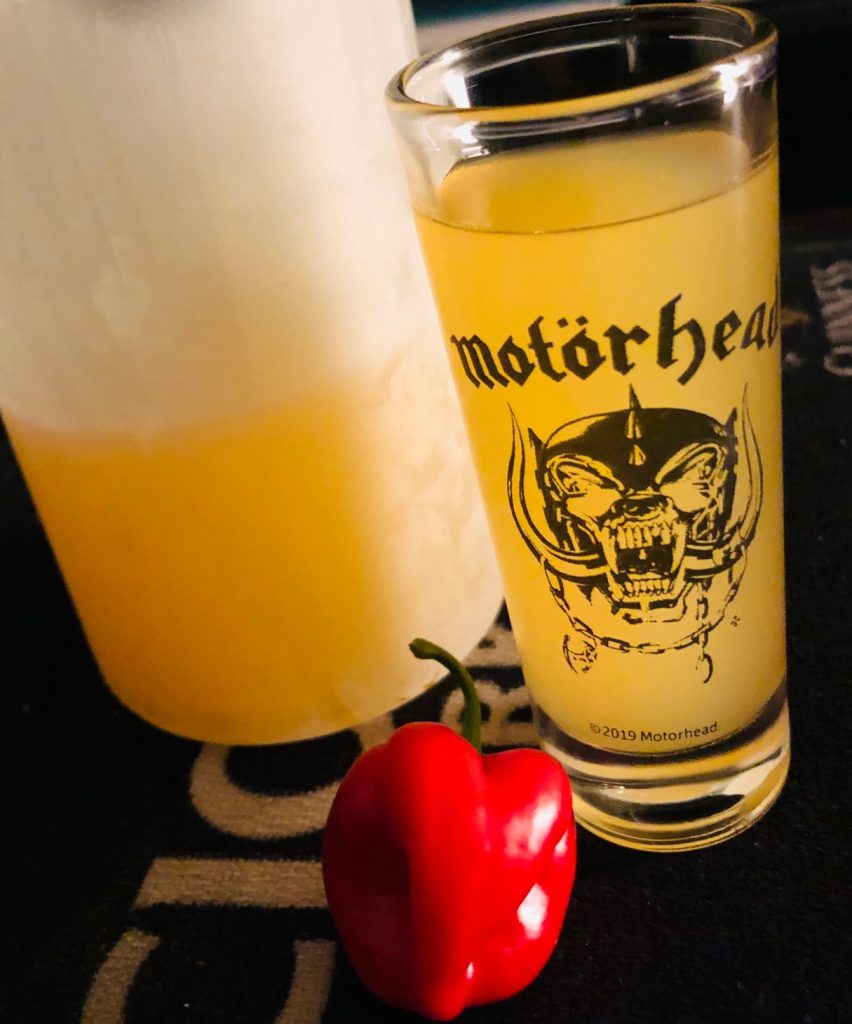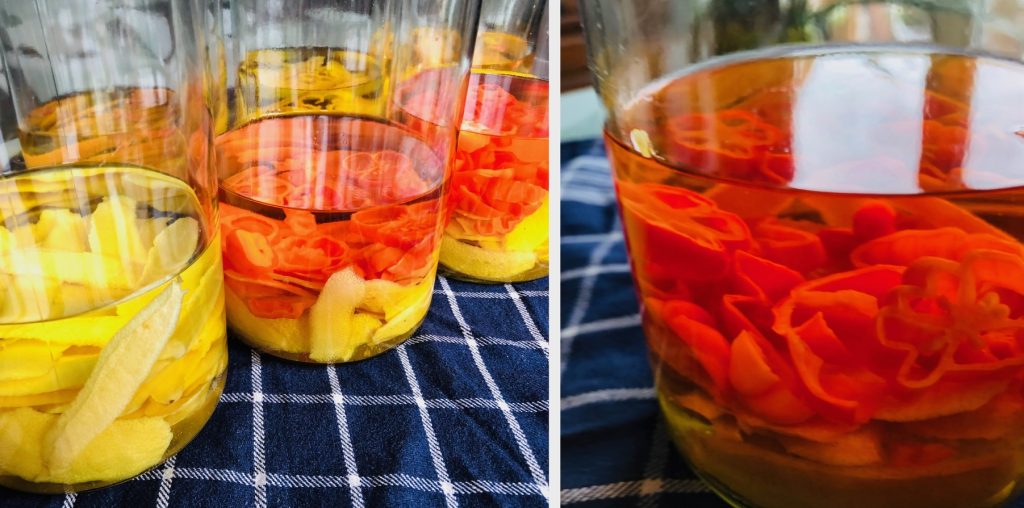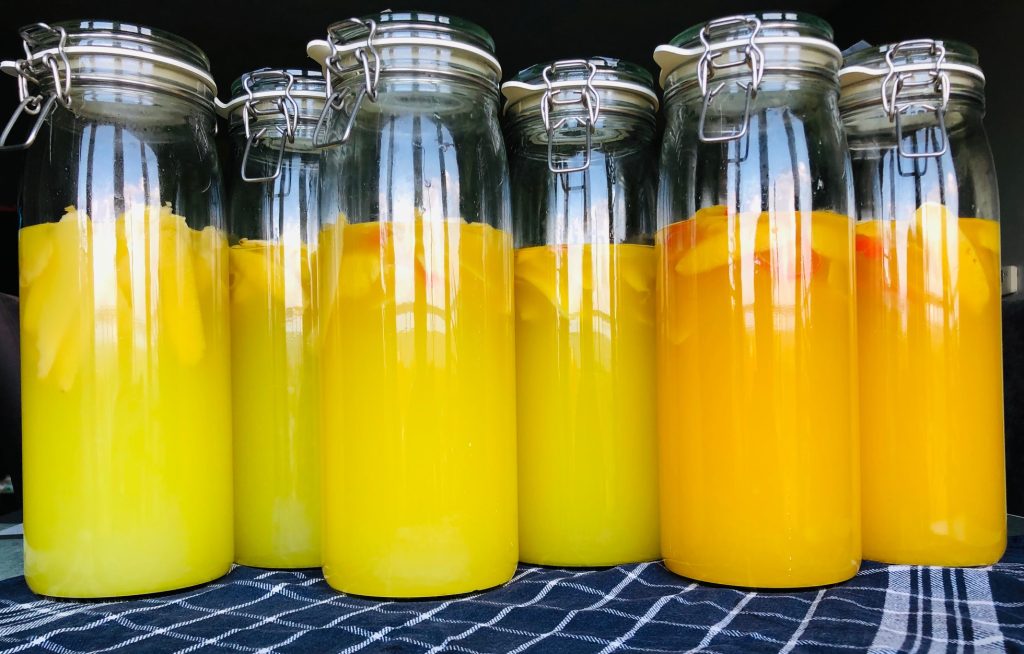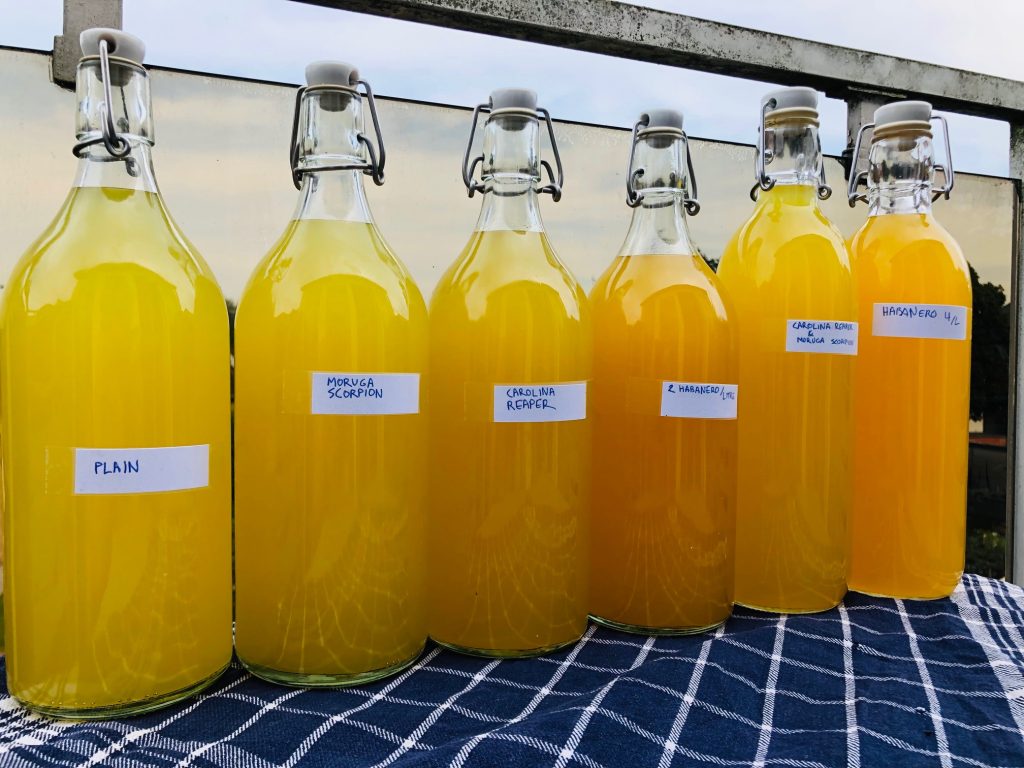This spicy variation on the Italian classic is
simply mouthwatering! It works great as
an appetiser, digestive or just as a side
when having drinks among friends.

Introduction
Limoncello is a well-known Italian classic that is loved by many. It’s both enjoyed as an appetiser when summer is in full swing or as a digestive after dinner at your favourite Italian. It’s also available form the liquor section in grocery stores worldwide, but let me tell you right now, once you’ve tried this one, you’ll never ever buy it again. After making a first batch, I’ve made many more and I pretty much always have Limoncello in my freezer ever since.
The reasons for that are obvious:
(1) Limoncello is super nice
(2) Limoncello is easy to make
(3) Limoncello is quick to make
(4) Limoncello should ALWAYS be drank ice and ice cold
The recipe I share below is based on one I received from an Italian friend, which I’ve spiced up, as that’s what I like to do. Skip the peppers in the recipe and it still makes for a great non-spicy limoncello, one that I typically make along with any batch of spicy ones I start.
I intentionally called this recipe Habanero limoncello instead of spicy limoncello, as I want to emphasise how – in my humble opinion – habanero and limoncello really are a match made in heaven. Habanero peppers have some lemony touches to their flavour, which really makes them blend in more perfectly into limoncello than any other peppers I’ve tried before. I’m quite sure you won’t be surprised I’ve tried a few? Below I show some examples of peppers I’ve tried last summer, but I would encourage anyone to experiment with your own favourites and adjust the amount of chilis added to your liking. The same holds for the other ingredients, it’s relatively straightforward to play with ratios to adjust the flavour to your liking. At the same time it might also be interesting to play with the infusion period in the different steps to fine tune the flavour to your personal taste. What I’ve described here is my base recipe that I really enjoy, but I expect to still adjust it and experiment further. Should I find a better combination, I won’t be shy to release it over here!
The recipe is described starting from 1 litre of pure alcohol, which is sufficient to make a total of about 3 litres of limoncello. The overall cost for these ingredients is about 50 EUR in Belgian supermarkets, meaning the cost per litre of final product is about 17 EUR. This is a common price to pay for just half a litre of commercial limoncello in retail over here, which definitely won’t be as good as your own!
Ingredients
- 1 Litre of “pure” alcohol (typically 96% ABV)
- 8 Lemons
- 1.2 kg Sugar
- 1.4 l Water
- Chili peppers to taste (3 to 12 Habaneros is my recommendation)
Preparation
So let’s get started. First of all, we need preservation jars that are sufficiently large. I typically use 2 litre jars in which I start from half a litre of alcohol, which makes about 1.5 litres of limoncello after 3 weeks. If you stick to the numbers listed in the ingredient list, you’d need a minimum volume of 3 litres if you want to work with a single jar, but you could just as well split the contents of one jar when adding the syrup after the initial infusion period.
We start by rinsing the lemons thoroughly with water (I typically leave them in water for an hour or so). Many people recommend organic lemons for making limoncello, I’ve never done so as I always feel like I’m getting ripped off when buying any organic vegetables and fruits. Most importantly, pick lemons of which the peel looks nice, healthy and which are sufficiently fresh. Subsequently we use a peeler (vegetable scraper) to slice off the lemon peels and mix them together with the alcohol in the preservation jar, as shown in the picture below.

In the run shown in the picture, I tested 6 varieties with my harvest from the 2021 chili pepper season. These were the mixes included in the experiment, with the amount of peppers per half litre of alcohol at the start and the total per litre at the end:
- Plain (no chili peppers / 0 peppers/litre)
- Moruga scorpion (1 chili / 0.667 peppers/litre)
- Carolina Reaper (1 chili / 0.667 peppers/litre)
- Habanero Red (3 chilis / 2 peppers/litre)
- Carolina Reaper & Moruga Scorpion (1 of each / 0.667 of each pepper/litre)
- Habanero Red (6 chilis / 4 peppers/litre)
The jars are then stored for one week in a dark and cold spot. A basement is perfect, but also a dark cupboard at room temperature will do fine.
After one week, the syrup needs to be prepared and added to the jars. For this the sugar and water are mixed into a cooking pot which is heated up slowly to dissolve the sugar. There’s no need to bring the mixture to the boiling point, but one should slowly stir util all of the sugar is dissolved. Subsequently let the mixture cool down and then add 1 litre to each preservation jar (when starting from half a litre of alcohol as done in the example here). Upon adding the syrup, the mixture will immediately convert to a typical limoncello colour, which might differ a bit depending on the peppers used. The preservation jars will then be stored for two more weeks in a cold and dark spot for the second stage of the infusion.

After two more weeks, our limoncello is just about ready. We only need to filter out the lemon peels and the chili peppers to end up with our final product. I typically filter the solution twice through simple coffee filters. A filter cloth would work just as well, use whatever you have available.

After filtering, the limoncello can be bottled and is ready for sampling. Well, nearly ready, it should first go into the freezer for a few hours, as limoncello is best when served ice cold.
I mentioned before that my personal favourite is Habanero limoncello, and both strengths tried here I really like. For those that are not into super spicy but like some punch, going lower than the numbers mentioned here will still be worthwhile I believe. To my surprise, the experiments with the Carolina Reapers and Moruga Scorpions were not crazy extreme in terms of heat levels, but of course they have the typical flavour of the peppers in there. Fans of these peppers won’t be disappointed, I’m still primarily in love with the Habanero flavour for limoncello. Carolina reaper has some smokiness to its aroma, which definitely is intriguing in Limoncello too.

All that’s left
for me to say is….
Cheers!
Serving tips
While anything I could say about regular limoncello also holds for Habanero limoncello, a few more serving tips might be useful…
- Serve ice and ice cold, really always preserve your limoncello in your freezer.
- Be aware that when not having spicy limoncello ice cold, the initial burn will be more intense.
- For the fun of it, you can put a spicy bottle of limoncello next to a regular one to give a bit of burn by surprise to your guests. Obviously only do this with people that can appreciate spicy stuff, I wouldn’t want to start any fights between you and your friends.
- Have this one as an appetiser for a spicy meal or as a digestive after, works really great during the summer grilling season!
